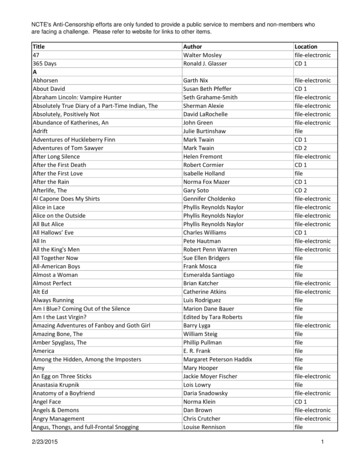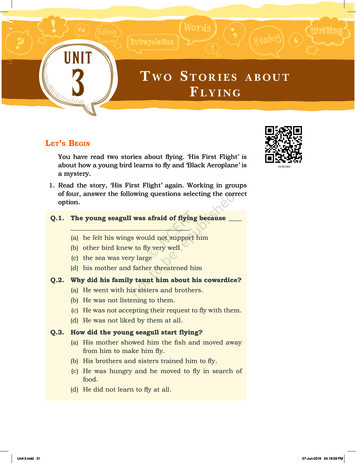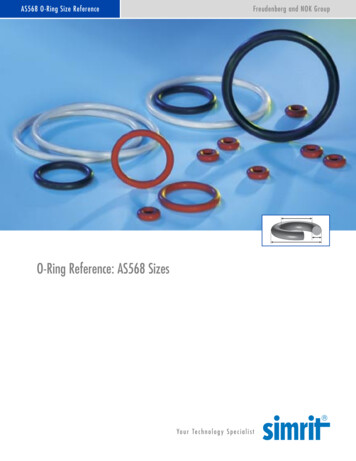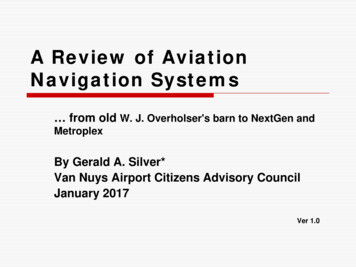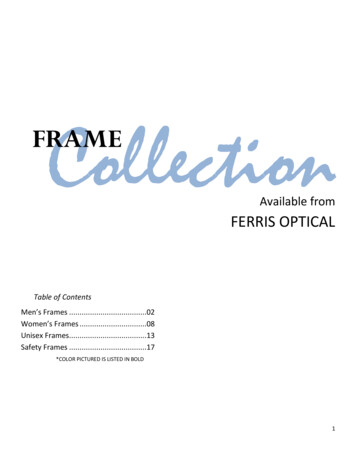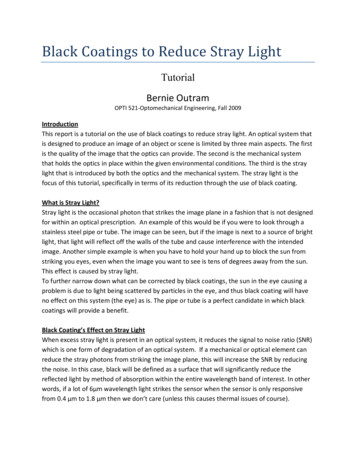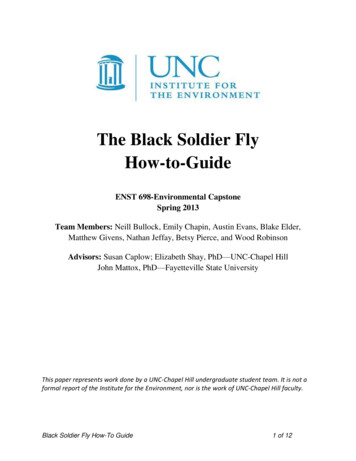
Transcription
The Black Soldier FlyHow-to-GuideENST 698-Environmental CapstoneSpring 2013Team Members: Neill Bullock, Emily Chapin, Austin Evans, Blake Elder,Matthew Givens, Nathan Jeffay, Betsy Pierce, and Wood RobinsonAdvisors: Susan Caplow; Elizabeth Shay, PhD—UNC-Chapel HillJohn Mattox, PhD—Fayetteville State UniversityThis paper represents work done by a UNC-Chapel Hill undergraduate student team. It is not aformal report of the Institute for the Environment, nor is the work of UNC-Chapel Hill faculty.Black Soldier Fly How-To Guide1 of 12
Table of ContentsI.Table of Contents2II.Statement of Purpose3III.Introduction3IV.Optimal conditions for BSFLTemperatureDietHumidityAdditional environmental conditions4V.Where to get BSFL5VI.Determining scale (calculator)5VII. How to build a BSFL feeding operationLarge ScaleMedium to Small Scale6VIII. Attracting your own colony of Black Soldier FliesNatural Distribution of Black Soldier FliesBlack Soldier Breeding8IX.How to Build an Indoor Black Soldier Fly breeding operation9X.Feasibility of off-season breeding10XI.Value of BSFL and their byproduct11XII. Works CitedBlack Soldier Fly How-To Guide122 of 12
Statement of PurposeThis How-to Guide is meant to serve as a resource for farms of all types and sizes andindividuals who are interested in implementing a black soldier fly-based waste managementsystem. It was produced by a group of eight students at the University of North Carolina atChapel Hill as part of their senior capstone project with the support of UNC’s Institute for theEnvironment and Pickards Mountain Eco-Institute in Orange County, North Carolina.IntroductionBlack soldier flies are small, harmless insects that have the potential to provide promisingsolutions to two of modern agriculture’s growing problems: the high cost of animal feed and thedisposal of large amounts of animal waste. Many farms now operate as linear systems,purchasing animal feed and then paying to eliminate waste from farm animals. Recent researchhas indicated that black soldier fly may be instrumental in closing the loop between animal wasteand animal feed (Watson, 2005). Black soldier fly larvae (BSFL) will eat nearly any kind oforganic waste ranging from animal waste to food scraps. As the BSFL mature, they grow into ½inch-long grubs, at which point they climb out of their food source and turn into pupae. Thepupae can immediately be fed to chickens and are a good source of protein. They can also bedried and processed into feed for use at a later time. Small composting operations also allowthem to turn into flies and breed, propagating the population.Black Soldier Fly LarvaeBlack Soldier Fly AdultBlack soldier flies are beneficial in several ways. The adults are not attracted to humanhabitation and thus pose a significantly lower risk of disease transmission than other fly species(Newton et al., 2005). Furthermore, they prevent houseflies and other insects from laying eggs inthe material inhabited by BSFL. The adults do not have digestive organs, relying on stores ofbody fat from the larval stage. Their short life cycle makes them a reliable source of food forchickens and potentially other farm animals. Previous work has also shown that black soldierflies are effective in reducing the mass as well as nutrient and moisture content of various kindsof organic waste.Black Soldier Fly How-To Guide3 of 12
This how-to guide will help anyone interested in using BSFL for composting, animalwaste reduction, or feeding animals. This guide suggests a few potential set-ups, depending onthe desired scale of BSFL cultivation. It also outlines many of the logistics of raising BSFLsuccessfully, including where to get BSFL to start an operation, how to build the set-up, howBSFL can be used to substitute chicken protein supplement, and how to breed BSFL in captivity.Optimal conditions for BSFLTemperatureThe optimal temperature at which BSFL consume their food is around 95 F. The minimumtemperature for survival is 32 F for no more than four hours, whereas the maximum temperatureallowing survival is 113 F. The larvae will become inactive at temperatures less than 50 F andtemperatures higher than 113 F, where their survival decreases dramatically. The best range oftemperature for the larvae to pupate is from 77 to 86 F. For mating purposes, optimaltemperature is around 82 F (Zhang, 2010).DietBSFL can tolerate a widely varied diet. The BSFL feed on many kinds of organic waste such astable scraps, composting feed, and animal manure. They can also survive off of coffee groundsfor a few weeks, but coffee grounds are not a sustainable diet. The caffeine from the coffeegrounds helps to boost the metabolism and makes the grubs more active. A diet combiningkitchen scraps and coffee grounds may help to boost their metabolism. The BSFL have a limitedability to process any animal products such as meat and fat.HumidityBlack soldier fly larvae develop most rapidly at 70 percent humidity. The rate of weight loss forthe BSFL increases with decreasing humidity. The optimal humidity for black soldier fly matingis around 30 to 90 percent. It is very important to monitor humidity for captive rearing andbreeding. We found that it is especially important to keep the grubs’ feeding medium at a propermoisture level—not so dry that it cements the grubs into the feed, and not so wet that they cannotbreathe through the pores in their exoskeleton.Additional environmental conditionsBSFL do not survive well in direct light or in extreme dry or wet conditions. They prefer to be 89 inches deep in their food source. If they are too far below the surface, they will perform littlebioconversion. Female flies avoid any sites that are anaerobic when trying to lay eggs.Black Soldier Fly How-To Guide4 of 12
Where to get BSFLBlack soldier fly larvae can be purchased from the Phoenix Worm Store. You can reach theirwebpage by following this link: www.phoenixworm.com/. The name ‘Phoenix worms’ is a termcommonly used for BSFL sold for pet feed. The Phoenix Worm Store guarantees live delivery ofyour order when the daytime temperatures are between 35 and 85 F. You can order varyingquantities and sizes of BSFL from this company. When deciding on the quantity of BSFL toorder, consider the time frame for getting an operation running at the desired capacity. To reach alarge capacity in a short amount of time, consider buying the larger quantity (600 for 27.95).For most cases, the smallest amount (100 ) will be sufficient and only costs 5.99. The portionsreceived are very generous.Determining scale (calculator)In order to determine the scale we needed to apply to Pickards Mountain to fully replace theirprotein supplements for chicken feed, we created a calculation tool using the amount of feed theycurrently buy & the percentage of raw protein in it. This turned out to be 100 lbs at 16%.According to a study performed in Texas by ERS International (ERSI 2008), BSFL are composedof 42.1% protein. Using the amount of protein we needed to replace each week from their feed,we determined that a little over 17 kilograms of larvae would be necessary. According to thesame study, a diagram of the area needed showed ratios of the input of waste and the output asfive to one. Using the same proportions, we determined that about 86 kilograms of waste perweek is needed to cover an area of 0.82 m2. We also determined that if we were able to produce1.2 million larvae, we would be able to efficiently remove that much waste per week. Using thisdata, we would be able to create a structure that, should we produce sufficient larvae, wouldgrow and harvest enough BSFL to replace PMEI’s chicken feed protein supplement.This calculation can be run by embedding the following lines of code into an htmlwebsite. html head Input desired protein form here: !-- This will change the wording above the text box -- br /br div id 'main' form onsubmit "return redirect()" input id "search form input" type "number" name "query" / kg/m 2 !-- This will change the wording next to the text box -- input type "submit" value "Calculate" / /form Black Soldier Fly How-To Guide5 of 12
/div script type "text/javascript" function redirect(){var query document.getElementById('search form input').value;if (query ! '') {// The variables below are fine, but the numbers can changevar grubs (query * 1.585600625459897);var tub (query * 22198.417954378219279);var grubtub (query * 0.015085853568801);document.write("You will need approximately " grubs "kg of waste tofeed approximately " tub " grubs. You will need " grubtub " m 2 area for your grubtub.");}return false;} /script "Be sure to hit refresh in order to input new calculations" !-- This will change the wordingbelow the text box -- /head /html How to build a BSFL feeding operationThe first step is to determine the scale of the operation for BSFL feeding based on the amount ofwaste that is produced or the quantity of chicken feed that is desired. See the previous section formore information on how to determine the scale of your operation.Large ScaleLarge-scale operations will likely be classified as Animal Feed Operations (AFO) which caninclude swine, cattle, and poultry.1 Materials will include concrete and wood to form the basin, gutter/PVC piping, and 5gallon collection buckets (see description for information on automation).2 Costs are highly variable depending on setup and scale.Black Soldier Fly How-To Guide6 of 12
This large-scale design is based on a study done by NC State researcher Wes Watson.The researchers found that “Black Soldier Flies are most easily managed in concrete basinsdirectly under caged layers of swine” (Watson). Depending on the existing infrastructure, thiscan be an effective and low-cost option. The researchers also built a separate facility for BSFLfeeding. For the separate facility, waste from the drained AFO travels along a conveyor belt,allowing liquid waste to drain off into collection troughs running alongside the conveyor. Theseparated solids are spread onto a larvae culture basin using a compressed air pump to deliverswine waste to a spreader that travels on a dolly along a beam above the basin. This exemplifiesan effective automated method of growing BSFL, albeit costly. The residue (digested manure)was manually removed before new manure was placed in the basin.The larvae culture basin was made of poured concrete. The surface area is dependent onthe scale of the project, as noted in the calculations section. The basin is enclosed by 1ft-highvertical walls on three sides, and the fourth side has a 40-degree incline leading to a rain gutter orhalved PVC pipe, closed on one side, and emptying into a bucket on the other.(Watson, 1/18/2013)Medium to Small ScaleMedium- to small-scale operations include free-range animal husbandry, farms that have a mixof animals, or residential homes that have pet waste and/or compost. For a medium- to smallscale operation, a modular approach will be more effective, allowing for the BSFL operation tobe easily scalable. Each modular unit is referred to as a grub tub.1 Materials for a single grub tub will include a plastic tote bin ( 20 gallon, depends on thequantity of waste available), 2”x10’ PVC pipe, 2x 90-degree PVC elbow joints, and a 5gallon collection bucket2 Cost of each grub tub is about 60. An alternative is to purchase a pre-made systemcalled the BioPod which retails for around 200.To build a grub tub, cut two equal sections of PVC pipe so that the grubs can travel fromthe center of the tub, out the side of the tub (through a hole cut in the plastic), and into acollection bucket. The PVC pipe should protrude approximately six inches from the tub. FromBlack Soldier Fly How-To Guide7 of 12
the protruding end, place the elbow joint and a small section of PVC to reach the lip of thecollection bucket. Cut the bottom 6 inches of the PVC in half along the length of the pipe tocreate a larger opening for the larvae to enter. The goal is to have the migrating BSFL drop in the5-gallon collection bucket, from which they cannot escape.The grub tub must be filled with a food source manually. When filling, be sure that theopened end of the PVC lies above the level of the manure so that BSFL have easy access to thepoint of exit.Source: ermimans-diy-bsfl-bin/Attracting your own colony of Black Soldier FliesNatural Distribution of Black Soldier FliesThe black soldier fly is a native insect to North America and is found throughout many parts ofthe United States. In the U.S. they are most active and common in the southeast. They are alsofound throughout the Western Hemisphere. Black soldier flies are especially abundant in thesubtropics and warm temperate regions (Tomberlin, 57). Attracting black soldier flies for naturalbreeding will be easiest in the regions of the United States where they are most abundant.Black Soldier BreedingWithin a few days of becoming an adult, the black soldier fly finds a mate. During their naturalbreeding process, the black soldier flies lay their eggs near a potential food source (Diclaro IIand Kaufman). Because they are found outdoors and often near agriculture settings, black soldierflies are often found around decaying matter. They are known to thrive in various kinds ofdecaying matter like manure, carrion, plant refuse, and waste products of beehives (Black SoldierBlack Soldier Fly How-To Guide8 of 12
Fly). When the female lays her eggs, she deposits close to 500 eggs (Black Soldier Fly). Unlikeother species of flies, the black soldier fly does not lay their eggs directly on the decayingorganic material. The black soldier flies like to lay their eggs in cracks and crevices near theorganic material since the larvae will then consume this material upon hatching. The adults flyonly during the warm months of the year, beginning in April and lasting through October(Tomberlin, 58).A native colony of black soldier flies can be started in the warm months by attracting thefemale black soldier flies to lay their eggs near a source of food with a strong odor. One methodto attract the black soldier flies is to start a compost bin using a mix of kitchen scraps that are acouple of days old. This mix of kitchen scraps can include any kind of vegetable scraps, corn onthe cob, rotten potatoes, coffee grounds, fruit scraps or other types of putrescent compost. Thefemales ready to lay eggs can detect in the air the chemical signal of a future larval-food source.Black soldier flies will likely be more abundant in rural areas of the country. In theseareas it is probably sufficient to attract the BSF using old kitchen scraps. In urban locations,black soldier flies may be more difficult to attract with kitchen scraps. Another method to attractblack soldier flies in urban areas is to ferment dried corn kernels by soaking them in the water(“Attracting Black Soldier Flies”). Once the corn kernels ferment, the mixture releases a strongodor that can be useful for attracting black soldier flies. Sour milk may be another good option.Black soldier flies like to lay their eggs in cracks and crevices that are removed from theirfood source. You can provide an ideal place for females to lay their eggs using commoncorrugated cardboard. Cut small strips of corrugated cardboard and attach them to the containerholding the food scraps or fermented corn kernels. Make sure the crevasses of the cardboard areexposed to the female in order to have a place for her to lay the eggs.The average time it takes to start a colony using this natural method is roughly two weeks.However it will also depend on the concentration of black soldier flies in the area (“How theBiopod Works”). Larvae won’t develop into adults until the weather is warm so it is necessary towait until the warmer months of the year to start a BSF colony (April through November).In the warm months, you can maintain a colony of flies by building an outdoor screenenclosure in order to keep the black soldier flies from migrating. The structure needs to beseveral feet wide and tall because the flies need ample space to fly and breed.How to build an indoor Black Soldier Fly breeding operationIf you are looking for a year-round or large-scale BSFL operation, you will need an indoor(enclosed and heated) breeding setup. Breeding tends to be more successful when there is openspace to fly around and mate (adult black soldier flies mate in flight). Netting can be used toenclose the adult flies. Light is crucial because black soldier fly breeding typically only happensBlack Soldier Fly How-To Guide9 of 12
when direct light is present. Natural sunlight from a window or skylight works best, but matingcan occur with bright fluorescent lights set on a timer to mimic sunlight. High relative humidityis necessary for the larvae to successfully pupate into adults, and mating between adult flies hasbeen shown to occur between 30 and 90% relative humidity. Some kind of plant (real orartificial) is needed to serve as a lekking location. Lekking is a mating behavior exhibited by themales of a species, where they congregate in certain areas and “call” to the females of the species.For black soldier flies, these lekking areas are characterized by the presence of leafy vegetation.As females approach the lekking areas, males rise and grasp onto a nearby female and descendback to the ground in copula. Small pieces of corrugated cardboard provide an ideal location forthe females to lay their eggs. The cardboard should be placed near an odorous food source(which will attract the female by smell). Once deposited, eggs can take anywhere from 4 days to3 weeks to hatch and should be kept out of water. They can be collected and stored in coolconditions to slow incubation. It is worth noting that experimental efforts at rearing black soldierflies in indoor cages have had mixed results. You may have to try various methods in order tosuccessfully breed black soldier flies indoors.Feasibility of off-season breedingOff-season breeding is dependent on access to a suitable location for a breeding setup, and thecharacteristics of that location will affect materials, costs, and success. Black soldier flies cansurvive in very cold temperatures by slowing their metabolism and going dormant. Althoughlarvae and flies can survive near-freezing conditions during the off-season, they will slow theirrate of development and not be able to breed. Black soldier flies require warm temperatures forbreeding in order to ensure higher likelihood of egg survival. This brings up two possiblescenarios that could result in a successful and continuing influx of new eggs and larvae to yourfeeding operation during cold months.Indoor off-season breeding is not out of the question, but is difficult. If the righttemperature and humidity are maintained in your setup, the larvae may grow and reach thepupating stage, but actual breeding is much harder to induce. Black soldier flies mate while inflight, so configuring a setup that is indoors and provides enough space to allow flight isnecessary. The enclosed space needs to be several feet tall and wide. A well-sealed greenhouseor lab space may suffice.This guide has previously discussed ways to create an outdoor environment that willattract mating black soldier flies and allow them to lay their eggs in targeted areas where theycan be collected. In the off-season, the only feasible way to breed outdoors is in a semi-openstructure that mimics these same conditions but is insulated heavily and is temperature regulatedby an external source, such as heat lamps or heated floors. This setup requires more materialsBlack Soldier Fly How-To Guide10 of 12
and energy costs, as well as increased likelihood of losing eggs. This should be taken intoconsideration if an indoor location is unavailable.A third option that is not as well-documented or tested is the collection and storage ofeggs produced during the regular season by freezing them and thawing them out as needed.There is mixed literature regarding other species of flies that can be frozen and thawed withoutmortality. To our knowledge, nothing specifically about BSFL has been researched. Many BSFLusers have expressed their interest in this topic on BSF forums, and have gotten no concreteanswers. It is known that the larvae and flies themselves can survive at low—but not freezing—temperatures, but nothing has been done with the eggs. Other fly eggs, such as screwworm flies,have been lab frozen, thawed, and reared to adulthood with low mortality (Suszkiw). However,fruit fly eggs have been seen to die when facing extended exposure to below-freezingtemperatures. If it is possible to freeze black soldier fly eggs, it might be the most feasible optionfor continuing off-season larvae growth.Value of BSFL and their byproduct:If BSFL production exceeds the need for chicken protein supplements on-site, they can be soldas a dried food stock. Given the price of 16% protein chicken feed (Purina Layena Pellets) andthe feed consumption for 45 free-range chickens at PMEI, we estimate the value of BSFL atapproximately 1.05/lb. The manure byproduct produced from BSFL operations is anothervaluable end product that can be used in the same manner as compost. After treatment by BSFLthe manure is no longer too hot (nutrient-rich) to apply to crops. Given that the manurebyproduct is derived from animal waste, there are likely restrictions on usage and trade; thus theBSFL would be most appropriate for onsite use.Black Soldier Fly How-To Guide11 of 12
Works CitedBiosystems, Design, 2013. A Primer on Black Soldier Fly. Date accessed: 20 Apr. 2013. URL:http://biosystemsblog.com/fishmeal/.Bradley, S.W., D.C. Sheppard, 1984. “House Fly Oviposition Inhibition by Larvae of Hermetia illucens,The Black Soldier Fly”. Journal of Chemical Ecology 10.6: 853 – 859.Diclaro II, J., and P. Kaufman, 2013. "Black Soldier Fly - Hermetia illucens." FeaturedCreatures.University of Florida. Date accessed: 10 Apr 2013. black soldier fly.htm.ESR International,2008. Bio-Conversion of Putrescent Waste. Date accessed: 21 May 2013. .ESR International, 2013. "How the Biopod Works." Biopod: The Future of Food Waste Diversion &Recycling. Date accessed: 10 Apr 2013. URL: an, D.P., R.D. Young, and E.P. Catts, 1959. “Hermetia illucens (Linnaeus) as a factor in the naturalcontrol of Musca domestica Linnaeus.” Journal of Economic Entomology 52.5: 917–921.Hamilton, M. and A. Hess, 2011. "Attracting Black Soldier flies." Homesteading Year 7. Date accessed:10 Apr 2013. URL: http://www.waldeneffect.org/blog/Attracting black soldier flies/Newton, G. L., D. C. Sheppard, D. W. Watson, G. J. Burtle, C. R. Dove, J. K. Tomberlin, and E. E.Thelen, 1984. “The Black Soldier Fly, Hermetia illucens, as a manure management/resource recoverytool.” Symposium on the state of the science of Animal Manure and Waste Management: 5-7.North Carolina State University, 2013. "Black soldier fly." Date accessed: 10 Apr 2013. URL: http://ipm.ncsu.edu/AG369/notes/black soldier fly.html .Suszkiw, J., 2005. Frozen Fly Eggs Thawed, Reared to Adulthood. United States Department ofAgriculture. Date accessed: 21 May 2013. URL: erlin, J., 2001. Biological, Behavioral, and Toxicological Studies on the Black Soldier Fly (Diptera:Stratiomyidae). Dissertation, University of Georgia: Athens, GA. Date accessed: 21 May 2013. /10724/5448/tomberlin jeffrey k 200108 phd.pdf?sequence 1.Tomberlin, J. K., and D. C. Sheppard, 2001. “Lekking Behavior of the Black Soldier Fly(Diptera:Stratiomyidae)”. The Florida Entomologist 84.4: 729–730.Watson, W., L. Newton, C. Sheppard, G. Burtle, and R. Dove, 2005. Using the Black Soldier Fly as aValue-Added Tool for the Management of Swine Manure. North Carolina State Univer: Raleigh NCZhang J, Huang L, He J, Tomberlin JK, Li J, Lei C, Sun M, Liu Z, & Yu Z. (2010). “An artificial lightsource influences mating and oviposition of black soldier flies, Hermetia illucens.” Journal of InsectScience 10:202 available online: insectscience.org/10.202Black Soldier Fly How-To Guide12 of 12
Black Soldier Fly How-To Guide 1 of 12 The Black Soldier Fly How-to-Guide ENST 698-Environmental Capstone Spring 2013 Team Members: Neill Bullock, Emily Chapin, Austin Evans, Blake Elder, Matth

